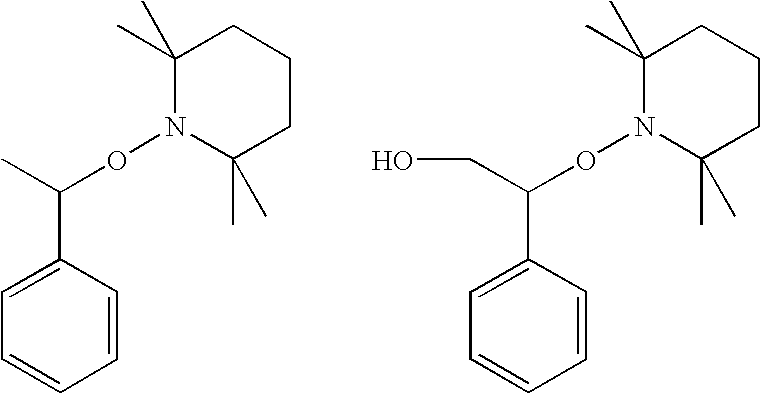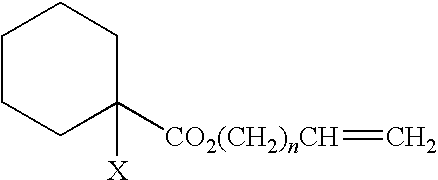Curable composition for damping material and damping material
a technology of curable composition and damping material, which is applied in the field of curable composition for damping materials and a damping material, can solve the problems of uneconomical industrial production, and achieve the effects of excellent oil resistance, excellent heat resistance and weather resistance, and low viscoelastic behavior
- Summary
- Abstract
- Description
- Claims
- Application Information
AI Technical Summary
Benefits of technology
Problems solved by technology
Method used
Image
Examples
production example 1
Method of Producing an N-Butyl Acrylate Polymer Having an Alkenyl Group at Both Termini
[0340]CuBr (1.09 kg), acetonitrile (11.4 kg), n-butyl acrylate (26.0 kg) and diethyl 2,5-dibromoadipate (2.28 kg) were added to a nitrogen-substituted 250-L reactor equipped with a stirrer and a jacket, and the mixture was stirred at 70° C. for about 30 minutes. Triamine (43.9 g) was added to initiate the reaction. n-Butyl acrylate (104 kg) was continuously added dropwise during the reaction. While n-butyl acrylate was added dropwise, triamine (176 g) was added in portions. Four hours after the reaction was initiated, the mixture was stirred under heating at 80° C. under reduced pressure, thereby evaporating the unreacted monomer and acetonitrile. Acetonitrile (45.7 kg), 1,7-octadiene (14.0 kg) and triamine (439 g) were added to the concentrate, and the mixture was stirred for 8 hours. The mixture was stirred under heating at 80° C. under reduced pressure, thereby evaporating acetonitrile and the ...
production example 2
Method of Producing an N-Butyl Acrylate Polymer Having a Crosslinkable Silyl Group at Both Termini
[0343]The polymer [P1] (65 kg), dimethoxymethylhydrosilane (1.1 kg), methyl o-formate (0.55 kg) and a solution of a platinum(0)-1,1,3,3-tetramethyl-1,3-divinyldisiloxane complex in xylene (10 mg in terms of platinum relative to 1 kg of the polymer) were added to a 140-L reactor pressure-resistant reaction container equipped with a stirrer and a jacket. In a nitrogen atmosphere, the mixture was stirred by heating at 100° C. for 1 hour. Volatiles in the mixture were distilled away under reduced pressure, whereby a crosslinkable silyl group-terminated n-butyl acrylate polymer ([P2]) was obtained. The number-average molecular weight of the resulting polymer [P2] as determined by GPC measurement (polystyrene equivalent) was 24600, and the molecular-weight distribution was 1.3. The average number of silyl groups introduced per molecule of the polymer, as determined by 1H NMR analysis, was 1.8...
production example 3
Method of Producing an N-Butyl Acrylate Polymer Having a Crosslinkable Silyl Group at Both Termini
[0344]The inside of a stainless steel reaction container equipped with a stirrer was deoxidized and then charged with cuprous bromide and a part (initially charged monomer) of whole butyl acrylate, and the mixture was heated under stirring. Acetonitrile and an initiator diethyl 2,5-dibromoadipate were added to, and mixed with, the mixture, and when the temperature of the mixture was regulated to about 80° C., pentamethyldiethylene triamine (abbreviated hereinafter as triamine) was added to initiate the polymerization reaction. The remaining butyl acrylate was added successively to proceed the polymerization reaction. During the polymerization, additional triamine was added properly to regulate the polymerization rate. The internal temperature was increased due to the polymerization heat with the progress of the polymerization, and thus the internal temperature was regulated to about 80°...
PUM
| Property | Measurement | Unit |
|---|---|---|
| mol % | aaaaa | aaaaa |
| mol % | aaaaa | aaaaa |
| molecular weight distribution | aaaaa | aaaaa |
Abstract
Description
Claims
Application Information
 Login to View More
Login to View More - R&D
- Intellectual Property
- Life Sciences
- Materials
- Tech Scout
- Unparalleled Data Quality
- Higher Quality Content
- 60% Fewer Hallucinations
Browse by: Latest US Patents, China's latest patents, Technical Efficacy Thesaurus, Application Domain, Technology Topic, Popular Technical Reports.
© 2025 PatSnap. All rights reserved.Legal|Privacy policy|Modern Slavery Act Transparency Statement|Sitemap|About US| Contact US: help@patsnap.com



